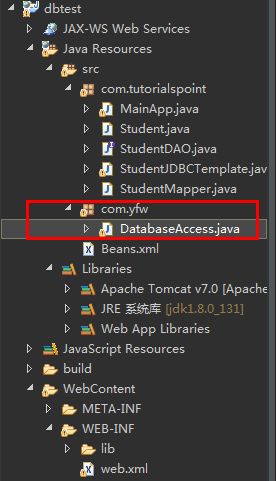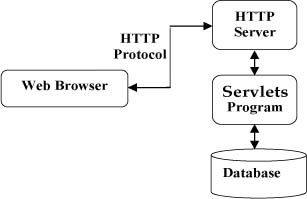Spring+Servlet 读取数据库并返回json数据到前端(java后端实践)
Spring简介:
Spring 框架是一个分层架构,由 7 个定义良好的模块组成。Spring 模块构建在核心容器之上,核心容器定义了创建、配置和管理 bean 的方式,如图 1 所示。
图 1. Spring 框架的 7 个模块
Spring 框架图示
组成 Spring 框架的每个模块(或组件)都可以单独存在,或者与其他一个或多个模块联合实现。每个模块的功能如下:
核心容器:核心容器提供 Spring 框架的基本功能。核心容器的主要组件是 BeanFactory,它是工厂模式的实现。BeanFactory 使用控制反转 (IOC) 模式将应用程序的配置和依赖性规范与实际的应用程序代码分开。
Spring 上下文:Spring 上下文是一个配置文件,向 Spring 框架提供上下文信息。Spring 上下文包括企业服务,例如 JNDI、EJB、电子邮件、国际化、校验和调度功能。 Spring
AOP:通过配置管理特性,Spring AOP 模块直接将面向方面的编程功能集成到了 Spring 框架中。所以,可以很容易地使 Spring 框架管理的任何对象支持 AOP。Spring AOP 模块为基于 Spring 的应用程序中的对象提供了事务管理服务。通过使用 Spring AOP,不用依赖 EJB 组件,就可以将声明性事务管理集成到应用程序中。
Spring DAO:JDBC DAO 抽象层提供了有意义的异常层次结构,可用该结构来管理异常处理和不同数据库供应商抛出的错误消息。异常层次结构简化了错误处理,并且极大地降低了需要编写的异常代码数量(例如打开和关闭连接)。Spring DAO 的面向 JDBC 的异常遵从通用的 DAO 异常层次结构。
Spring ORM:Spring 框架插入了若干个 ORM 框架,从而提供了 ORM 的对象关系工具,其中包括 JDO、Hibernate 和 iBatis SQL Map。所有这些都遵从 Spring 的通用事务和 DAO 异常层次结构。
Spring Web 模块:Web 上下文模块建立在应用程序上下文模块之上,为基于 Web 的应用程序提供了上下文。所以,Spring 框架支持与 Jakarta Struts 的集成。Web 模块还简化了处理多部分请求以及将请求参数绑定到域对象的工作。
Spring MVC 框架:MVC 框架是一个全功能的构建 Web 应用程序的 MVC 实现。通过策略接口,MVC 框架变成为高度可配置的,MVC 容纳了大量视图技术,其中包括 JSP、Velocity、Tiles、iText 和 POI。
Spring 框架的功能可以用在任何 J2EE 服务器中,大多数功能也适用于不受管理的环境。Spring 的核心要点是:支持不绑定到特定 J2EE 服务的可重用业务和数据访问对象。毫无疑问,这样的对象可以在不同 J2EE 环境 (Web 或 EJB)、独立应用程序、测试环境之间重用。
Servlet简介:
Java Servlet 是运行在 Web 服务器或应用服务器上的程序,它是作为来自 Web 浏览器或其他 HTTP 客户端的请求和 HTTP 服务器上的数据库或应用程序之间的中间层。
使用 Servlet,您可以收集来自网页表单的用户输入,呈现来自数据库或者其他源的记录,还可以动态创建网页。
Java Servlet 通常情况下与使用 CGI(Common Gateway Interface,公共网关接口)实现的程序可以达到异曲同工的效果。但是相比于 CGI,Servlet 有以下几点优势:
性能明显更好。
Servlet 在 Web 服务器的地址空间内执行。这样它就没有必要再创建一个单独的进程来处理每个客户端请求。
Servlet 是独立于平台的,因为它们是用 Java 编写的。
服务器上的 Java 安全管理器执行了一系列限制,以保护服务器计算机上的资源。因此,Servlet 是可信的。
Java 类库的全部功能对 Servlet 来说都是可用的。它可以通过 sockets 和 RMI 机制与 applets、数据库或其他软件进行交互。
一、Spring JDBC 读取数据库示例
Spring JDBC 示例
想要理解带有 jdbc 模板类的 Spring JDBC 框架的相关概念,让我们编写一个简单的示例,来实现下述 Student 表的所有 CRUD 操作。
CREATE TABLE Student(
ID INT NOT NULL AUTO_INCREMENT,
NAME VARCHAR(20) NOT NULL,
AGE INT NOT NULL,
PRIMARY KEY (ID)
);
在继续之前,让我们适当地使用 Eclipse IDE 并按照如下所示的步骤创建一个 Spring 应用程序:
| 步骤 | 描述 |
|---|---|
| 1 | 创建一个名为 dbtest的项目,并在创建的项目中的 src 文件夹下创建包 com.tutorialspoint。 |
| 2 | 使用 Add External JARs 选项添加必需的 Spring 库,解释见 Spring Hello World Example 章节。 |
| 3 | 在项目中添加 Spring JDBC 指定的最新的库 mysql-connector-java.jar,org.springframework.jdbc.jar 和 org.springframework.transaction.jar。如果这些库不存在,你可以下载它们。 |
| 4 | 创建 DAO 接口 StudentDAO 并列出所有必需的方法。尽管这一步不是必需的而且你可以直接编写 StudentJDBCTemplate 类,但是作为一个好的实践,我们最好还是做这一步。 |
| 5 | 在 com.tutorialspoint 包下创建其他的必需的 Java 类 Student,StudentMapper,StudentJDBCTemplate 和 MainApp 。 |
| 6 | 确保你已经在 TEST 数据库中创建了 Student 表。并确保你的 MySQL 服务器运行正常,且你可以使用给出的用户名和密码读/写访问数据库。 |
| 7 | 在 src 文件夹下创建 Beans 配置文件 Beans.xml。 |
| 8 | 最后一步是创建所有的 Java 文件和 Bean 配置文件的内容并按照如下所示的方法运行应用程序。 |
以下是数据访问对象接口文件 StudentDAO.java 的内容:
package com.tutorialspoint;
import java.util.List;
import javax.sql.DataSource;
public interface StudentDAO {
/**
* This is the method to be used to initialize
* database resources ie. connection.
*/
public void setDataSource(DataSource ds);
/**
* This is the method to be used to create
* a record in the Student table.
*/
public void create(String name, Integer age);
/**
* This is the method to be used to list down
* a record from the Student table corresponding
* to a passed student id.
*/
public Student getStudent(Integer id);
/**
* This is the method to be used to list down
* all the records from the Student table.
*/
public List<Student> listStudents();
/**
* This is the method to be used to delete
* a record from the Student table corresponding
* to a passed student id.
*/
public void delete(Integer id);
/**
* This is the method to be used to update
* a record into the Student table.
*/
public void update(Integer id, Integer age);
}
下面是 Student.java 文件的内容:
package com.tutorialspoint;
public class Student {
private Integer age;
private String name;
private Integer id;
public void setAge(Integer age) {
this.age = age;
}
public Integer getAge() {
return age;
}
public void setName(String name) {
this.name = name;
}
public String getName() {
return name;
}
public void setId(Integer id) {
this.id = id;
}
public Integer getId() {
return id;
}
}
以下是 StudentMapper.java 文件的内容:
package com.tutorialspoint;
import java.sql.ResultSet;
import java.sql.SQLException;
import org.springframework.jdbc.core.RowMapper;
public class StudentMapper implements RowMapper<Student> {
public Student mapRow(ResultSet rs, int rowNum) throws SQLException {
Student student = new Student();
student.setId(rs.getInt("id"));
student.setName(rs.getString("name"));
student.setAge(rs.getInt("age"));
return student;
}
}
下面是为定义的 DAO 接口 StudentDAO 的实现类文件 StudentJDBCTemplate.java:
package com.tutorialspoint;
import java.util.List;
import javax.sql.DataSource;
import org.springframework.jdbc.core.JdbcTemplate;
public class StudentJDBCTemplate implements StudentDAO {
private DataSource dataSource;
private JdbcTemplate jdbcTemplateObject;
public void setDataSource(DataSource dataSource) {
this.dataSource = dataSource;
this.jdbcTemplateObject = new JdbcTemplate(dataSource);
}
public void create(String name, Integer age) {
String SQL = "insert into Student (name, age) values (?, ?)";
jdbcTemplateObject.update( SQL, name, age);
System.out.println("Created Record Name = " + name + " Age = " + age);
return;
}
public Student getStudent(Integer id) {
String SQL = "select * from Student where id = ?";
Student student = jdbcTemplateObject.queryForObject(SQL,
new Object[]{id}, new StudentMapper());
return student;
}
public List<Student> listStudents() {
String SQL = "select * from Student";
List <Student> students = jdbcTemplateObject.query(SQL,
new StudentMapper());
return students;
}
public void delete(Integer id){
String SQL = "delete from Student where id = ?";
jdbcTemplateObject.update(SQL, id);
System.out.println("Deleted Record with ID = " + id );
return;
}
public void update(Integer id, Integer age){
String SQL = "update Student set age = ? where id = ?";
jdbcTemplateObject.update(SQL, age, id);
System.out.println("Updated Record with ID = " + id );
return;
}
}
以下是 MainApp.java 文件的内容:
package com.tutorialspoint;
import java.util.List;
import org.springframework.context.ApplicationContext;
import org.springframework.context.support.ClassPathXmlApplicationContext;
import com.tutorialspoint.StudentJDBCTemplate;
public class MainApp {
public static void main(String[] args) {
ApplicationContext context =
new ClassPathXmlApplicationContext("Beans.xml");
StudentJDBCTemplate studentJDBCTemplate =
(StudentJDBCTemplate)context.getBean("studentJDBCTemplate");
System.out.println("------Records Creation--------" );
studentJDBCTemplate.create("Zara", 11);
studentJDBCTemplate.create("Nuha", 2);
studentJDBCTemplate.create("Ayan", 15);
System.out.println("------Listing Multiple Records--------" );
List<Student> students = studentJDBCTemplate.listStudents();
for (Student record : students) {
System.out.print("ID : " + record.getId() );
System.out.print(", Name : " + record.getName() );
System.out.println(", Age : " + record.getAge());
}
System.out.println("----Updating Record with ID = 2 -----" );
studentJDBCTemplate.update(2, 20);
System.out.println("----Listing Record with ID = 2 -----" );
Student student = studentJDBCTemplate.getStudent(2);
System.out.print("ID : " + student.getId() );
System.out.print(", Name : " + student.getName() );
System.out.println(", Age : " + student.getAge());
}
}
下述是配置文件 Beans.xml 的内容:
<beans xmlns="http://www.springframework.org/schema/beans"
xmlns:xsi="http://www.w3.org/2001/XMLSchema-instance"
xsi:schemaLocation="http://www.springframework.org/schema/beans
http://www.springframework.org/schema/beans/spring-beans-3.0.xsd ">
<bean id="dataSource"
class="org.springframework.jdbc.datasource.DriverManagerDataSource">
<property name="driverClassName" value="com.mysql.jdbc.Driver"/>
<property name="url" value="jdbc:mysql://localhost:3306/TEST"/>
<property name="username" value="root"/>
<property name="password" value="password"/>
bean>
<bean id="studentJDBCTemplate"
class="com.tutorialspoint.StudentJDBCTemplate">
<property name="dataSource" ref="dataSource" />
bean>
beans>
当你完成创建源和 bean 配置文件后,运行应用程序。右键点击MainApp.java–>运行方式–>java应用程序(如下图所示):

如果你的应用程序一切运行顺利的话,将会输出如下所示的消息:
------Records Creation--------
Created Record Name = Zara Age = 11
Created Record Name = Nuha Age = 2
Created Record Name = Ayan Age = 15
------Listing Multiple Records--------
ID : 1, Name : Zara, Age : 11
ID : 2, Name : Nuha, Age : 2
ID : 3, Name : Ayan, Age : 15
----Updating Record with ID = 2 -----
Updated Record with ID = 2
----Listing Record with ID = 2 -----
ID : 2, Name : Nuha, Age : 20
二、 Spring JDBC+Servlet 返回json数据
在上面Spring JDBC的基础上加入servlet程序,提供web前端的访问接口(返回json数据)。
导入以下json依赖包(到WebContent\WEB-INF\lib目录下):
commons-logging-1.0.4.jar
commons-lang-2.3.jar
commons-collections-3.2.jar
commons-beanutils-1.7.0.jar
json-lib-2.2.1-jdk15.jar
1、在src目录下创建com.yfw包,在该包下创建DatabaseAccess类。

DatabaseAccess类程序如下:
package com.yfw;
import java.io.PrintWriter;
import java.io.IOException;
import java.util.List;
import javax.servlet.ServletException;
import javax.servlet.annotation.WebServlet;
import javax.servlet.http.HttpServlet;
import javax.servlet.http.HttpServletRequest;
import javax.servlet.http.HttpServletResponse;
import org.springframework.context.ApplicationContext;
import org.springframework.context.support.ClassPathXmlApplicationContext;
import com.tutorialspoint.Student;
import com.tutorialspoint.StudentJDBCTemplate;
import net.sf.json.JSONArray;
import net.sf.json.JSONObject;
/**
* Servlet implementation class DatabaseAccess
*/
@WebServlet("/DatabaseAccess")
public class DatabaseAccess extends HttpServlet {
private static final long serialVersionUID = 1L;
/**
* @see HttpServlet#HttpServlet()
*/
public DatabaseAccess() {
super();
// TODO Auto-generated constructor stub
}
/**
* @see HttpServlet#doGet(HttpServletRequest request, HttpServletResponse response)
*/
protected void doGet(HttpServletRequest request, HttpServletResponse response) throws ServletException, IOException {
ApplicationContext context = new ClassPathXmlApplicationContext("Beans.xml");
StudentJDBCTemplate studentJDBCTemplate = (StudentJDBCTemplate)context.getBean("studentJDBCTemplate");
response.setContentType("text/json; charset=utf-8");
PrintWriter out = response.getWriter();
JSONArray jsonarray = new JSONArray();
JSONObject jsonobj = new JSONObject();
List<Student> students = studentJDBCTemplate.listStudents();
for (Student record : students) {
jsonobj.put("ID", record.getId());
jsonobj.put("Name", record.getName());
jsonobj.put("Age", record.getAge());
jsonarray.add(jsonobj);
}
out = response.getWriter();
out.println(jsonarray);
}
/**
* @see HttpServlet#doPost(HttpServletRequest request, HttpServletResponse response)
*/
protected void doPost(HttpServletRequest request, HttpServletResponse response) throws ServletException, IOException {
// TODO Auto-generated method stub
doGet(request, response);
}
}
2、用Tomcat启动程序,浏览器访问http://localhost/dbtest/DatabaseAccess,会看到如下界面:

可以看到数据库中的数据,全部被转成了json格式发送给了,并输出到前端显示。
下载源码


